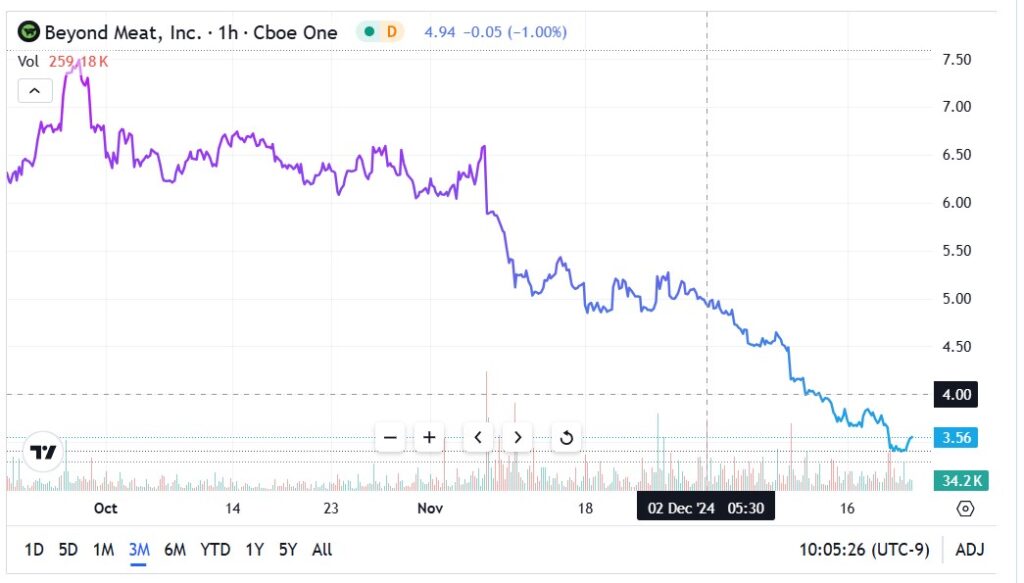On paper, Beyond Meat Inc BYND seemingly represents one of the more compelling investment opportunities. In 2022, a Deloitte survey revealed that 90% of younger consumers — despite encountering financial constraints — made at least some effort to reduce their environmental impact, including using plant-based foods. Unfortunately, this positive sentiment backdrop hasn’t done many favors for BYND stock in recent years.
One major clue that the business isn’t clicking is that Beyond continues to march forward with new product innovations but yielding no sustained positive price action in BYND stock. For example, shares temporarily popped higher in November when the company announced its latest product called Beyond Sun Sausage. Unfortunately, the pop was short-lived, with BYND losing about 31% of value in the trailing month.
Another clue is the poor financial performance. It’s true that Beyond is paring down its losses per share over the past few quarters. However, revenue growth has largely declined on a year-over-year basis. And with that, it’s hardly surprising that the vast majority of insider transactions have been sales of BYND stock.
Check This Out: Santa Claus Rally In 2024? Poll Shows Investors Split On End Of Year Returns, 57% Say This…

Finally, the immediate technical situation is difficult to ignore. Beyond Meat stock struggled to hold onto the critical $5 support line in November and it conspicuously failed to grip the $4 level as well. Even the $3.50 level appears questionable, tempting an options strategy called the bear call spread.
Underwriting the Risk That BYND Stock Will Stay Subdued
A distinct multi-leg transaction, the bear call spread — as implied in the name — represents a pessimistic trade. The basic idea is the trader entering the position anticipates the target security to fall in value. However, unlike a “directly” bearish wager, the bear call starts from a cash inflow position.
Structurally, the trader sells a call option for a given expiration date while simultaneously buying a call at a higher strike price. Naturally, the gross debit paid for the long call cuts into the income received from the short call credit. However, buying the long call is important in case the stock moves against the trader (i.e. in the upward direction).
Therefore, the bear call spread features a capped-risk, capped-reward opportunity. Effectively, the speculator is underwriting the risk that the target security will not rise above the breakeven threshold. Ideally, the stock in question will drop to the short call strike or slightly below to collect the maximum reward, which is called the yield.
Generally speaking, the higher the yield, the less likely it is that the bear call spread will pan out successfully for the risk underwriter. At the same time, extremely low yields may pose a significant positional risk due to the amount of capital in danger of incurring the maximum loss.
Targeting the $3.50 Level
For a quick yield opportunity, traders may consider selling the 3.50/4.00 bear call spread for the options chain expiring Jan. 3, 2025. At the time of writing, the individual process involves selling the $3.50 call at a bid of 20 cents and buying the $4 call at an ask of 12 cents. Applying the options multiplier, the maximum reward is $8 for every $42 at risk or a yield of slightly more than 19%.
While it’s not the most exciting reward, the timeframe comes out to only two business weeks. Further, BYND stock needs to fall to $3.50 (or lower) to receive the maximum yield. That’s a doable proposition given the security’s technical and fundamental woes.
Lastly, while businesses always have a chance at a comeback, Beyond Meat has consistently disappointed its stakeholders. Since the start of the year, BYND has lost about 56% of its value. With insiders not believing in their own stock, it’s a gargantuan task to convince outside investors to take the plunge.
Read Next:
Photo: Shutterstock
Market News and Data brought to you by Benzinga APIs